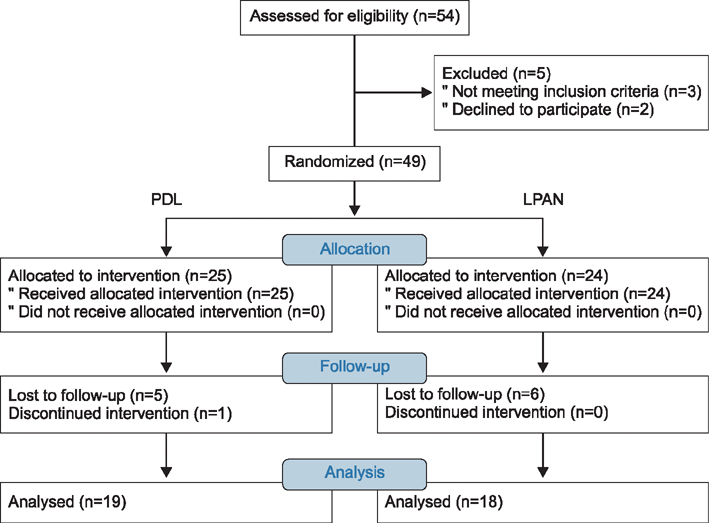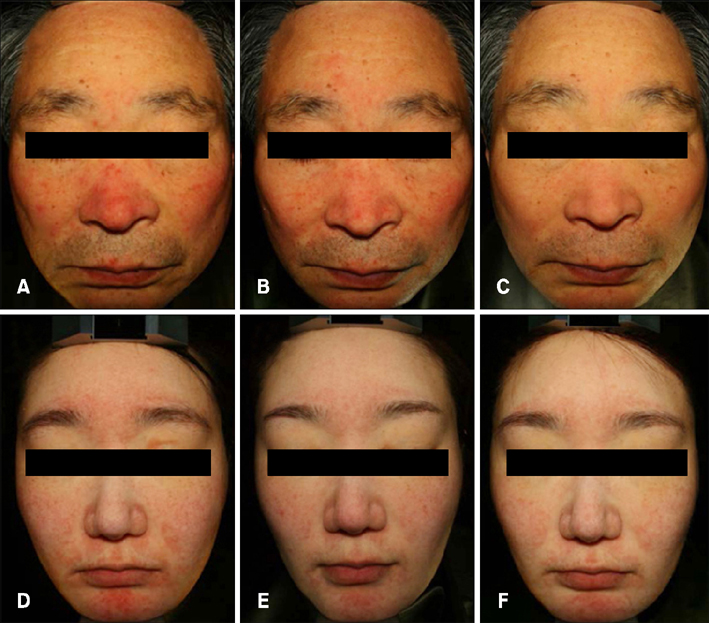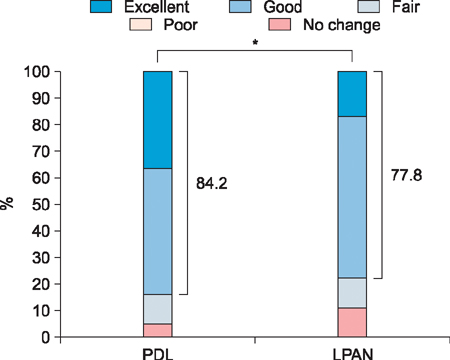Ann Dermatol.
2016 Oct;28(5):607-614. 10.5021/ad.2016.28.5.607.
Prospective Comparison of Dual Wavelength Long-Pulsed 755-nm Alexandrite/1,064-nm Neodymium:Yttrium-Aluminum-Garnet Laser versus 585-nm Pulsed Dye Laser Treatment for Rosacea
- Affiliations
-
- 1Department of Dermatology, Seoul St. Mary's Hospital, College of Medicine, The Catholic University of Korea, Seoul, Korea.
- 2Department of Dermatology, Kangbuk Samsung Hospital, Sungkyunkwan University School of Medicine, Seoul, Korea. susini@naver.com
- KMID: 2382886
- DOI: http://doi.org/10.5021/ad.2016.28.5.607
Abstract
- BACKGROUND
Rosacea treatments including oral/topical medications and laser therapy are numerous but unsatisfactory.
OBJECTIVE
To compare the effectiveness of the dual wavelength long-pulsed 755-nm alexandrite/1,064-nm neodymium: yttrium-aluminum-garnet laser (LPAN) with that of 585-nm pulsed dye laser (PDL) for rosacea.
METHODS
This was a randomized, single-blinded, comparative study. Full face received four consecutive monthly treatments with LPAN or PDL, followed-up for 6 months after the last treatment. Erythema index was measured by spectrophotometer, and digital photographs were evaluated by consultant dermatologists for physician's global assessment. Subjective satisfaction surveys and adverse effects were recorded.
RESULTS
Forty-nine subjects with rosacea enrolled and 12 dropped out. There were no significant differences between LPAN and PDL in the mean reduction of the erythema index (p=0.812; 3.6% vs. 2.8%), improvement of physician's global assessment (p=1.000; 88.9% vs. 89.5%), and subject-rated treatment satisfaction (p=0.842; 77.8% vs. 84.2%). PDL showed more adverse effects including vesicles than LPAN (p=0.046; 26.3% vs. 0.0%). No other serious or permanent adverse events were observed in both treatments.
CONCLUSION
Both LPAN and PDL may be effective and safe treatments for rosacea.
Keyword
MeSH Terms
Figure
Reference
-
1. Erceg A, de Jong EM, van de Kerkhof PC, Seyger MM. The efficacy of pulsed dye laser treatment for inflammatory skin diseases: a systematic review. J Am Acad Dermatol. 2013; 69:609–615.e8.
Article2. Powell FC. Clinical practice. Rosacea. N Engl J Med. 2005; 352:793–803.3. Crawford GH, Pelle MT, James WD. Rosacea: I. Etiology, pathogenesis, and subtype classification. J Am Acad Dermatol. 2004; 51:327–341. quiz 342-324.
Article4. Aksoy B, Altaykan-Hapa A, Egemen D, Karagöz F, Atakan N. The impact of rosacea on quality of life: effects of demographic and clinical characteristics and various treatment modalities. Br J Dermatol. 2010; 163:719–725.
Article5. Jansen T. Clinical presentations and classification of rosacea. Ann Dermatol Venereol. 2011; 138:Suppl 3. S192–S200.
Article6. Yamasaki K, Gallo RL. The molecular pathology of rosacea. J Dermatol Sci. 2009; 55:77–81.
Article7. Reinholz M, Tietze JK, Kilian K, Schaller M, Schöfer H, Lehmann P, et al. Rosacea-S1 guideline. J Dtsch Dermatol Ges. 2013; 11:768–780. 768–779.8. Cribier B. Pathophysiology of rosacea: redness, telangiectasia, and rosacea. Ann Dermatol Venereol. 2011; 138:Suppl 3. S184–S191.
Article9. Schwab VD, Sulk M, Seeliger S, Nowak P, Aubert J, Mess C, et al. Neurovascular and neuroimmune aspects in the pathophysiology of rosacea. J Investig Dermatol Symp Proc. 2011; 15:53–62.
Article10. van Zuuren EJ, Kramer SF, Carter BR, Graber MA, Fedorowicz Z. Effective and evidence-based management strategies for rosacea: summary of a Cochrane systematic review. Br J Dermatol. 2011; 165:760–781.
Article11. Pelle MT, Crawford GH, James WD. Rosacea: II. Therapy. J Am Acad Dermatol. 2004; 51:499–512. quiz 513-514.
Article12. Elewski BE, Draelos Z, Dréno B, Jansen T, Layton A, Picardo M. Rosacea-global diversity and optimized outcome: proposed international consensus from the Rosacea International Expert Group. J Eur Acad Dermatol Venereol. 2011; 25:188–200.
Article13. Baldwin HE. Systemic therapy for rosacea. Skin Ther Lett. 2007; 12:1–5. 914. Richards KA, Garden JM. The pulsed dye laser for cutaneous vascular and nonvascular lesions. Semin Cutan Med Surg. 2000; 19:276–286.
Article15. Alam M, Voravutinon N, Warycha M, Whiting D, Nodzenski M, Yoo S, et al. Comparative effectiveness of non-purpuragenic 595-nm pulsed dye laser and microsecond 1064-nm neodymium:yttrium-aluminum-garnet laser for treatment of diffuse facial erythema: a double-blind randomized controlled trial. J Am Acad Dermatol. 2013; 69:438–443.
Article16. Jasim ZF, Woo WK, Handley JM. Long-pulsed (6-ms) pulsed dye laser treatment of rosacea-associated telangiectasia using subpurpuric clinical threshold. Dermatol Surg. 2004; 30:37–40.
Article17. Zide BM, Levine SM. Hemangioma update: pearls from 30 years of treatment. Ann Plast Surg. 2012; 69:99–103.18. Kauvar AN, Lou WW. Pulsed alexandrite laser for the treatment of leg telangiectasia and reticular veins. Arch Dermatol. 2000; 136:1371–1375.
Article19. Li L, Kono T, Groff WF, Chan HH, Kitazawa Y, Nozaki M. Comparison study of a long-pulse pulsed dye laser and a long-pulse pulsed alexandrite laser in the treatment of port wine stains. J Cosmet Laser Ther. 2008; 10:12–15.
Article20. Su W, Ke Y, Xue J. Beneficial effects of early treatment of infantile hemangiomas with a long-pulse Alexandrite laser. Lasers Surg Med. 2014; 46:173–179.
Article21. Ahcan U, Zorman P, Recek D, Ralca S, Majaron B. Port wine stain treatment with a dual-wavelength Nd:Yag laser and cryogen spray cooling: a pilot study. Lasers Surg Med. 2004; 34:164–167.
Article22. Schulz KF, Altman DG, Moher D. CONSORT Group. CONSORT 2010 Statement: updated guidelines for reporting parallel group randomized trials. Open Med. 2010; 4:e60–e68.23. Say EM, Okan G, Gökdemir G. Treatment outcomes of long-pulsed Nd: YAG laser for two different subtypes of rosacea. J Clin Aesthet Dermatol. 2015; 8:16–20.24. Tardío JC, Pinedo F, Aramburu JA, Suárez-Massa D, Pampín A, Requena L, et al. Pleomorphic dermal sarcoma: a more aggressive neoplasm than previously estimated. J Cutan Pathol. 2016; 43:101–112.
Article
- Full Text Links
- Actions
-
Cited
- CITED
-
- Close
- Share
- Similar articles
-
- Anti-melanogenesis Effect of a Dual-delivery Long-pulsed 1,064-nm Neodymium-doped Yttrium Aluminum Garnet and 755-nm Alexandrite Laser on Human Skin Explants
- Intense Pulsed Light and Q-Switched 1,064-nm Neodymium-Doped Yttrium Aluminum Garnet Laser Treatment for the Scarring Lesion of Discoid Lupus Erythematosus
- Therapeutic effect of long-pulsed 1,064-nm Nd:YAG lasers on venous lakes in Korean patients: a case report
- Effective Treatment of Suspicious Riehl's Melanosis Using Low Fluence 1,064 nm Q-switched Nd:YAG Laser and 595 nm Pulsed Dye Laser
- Successful Treatment of Recalcitrant Plantar Warts Using Combined Long-pulsed Nd:YAG and Alexandrite Lasers





